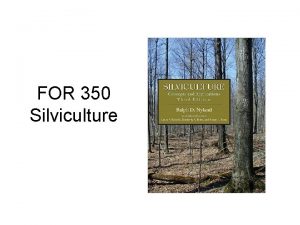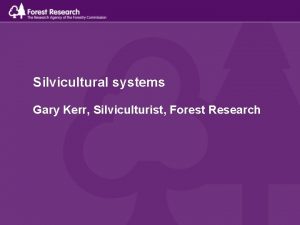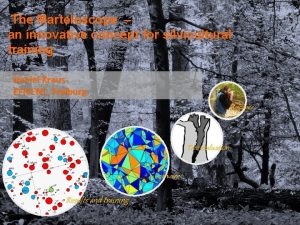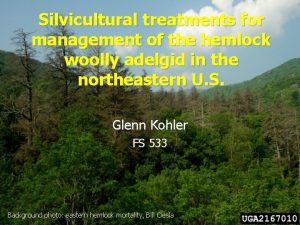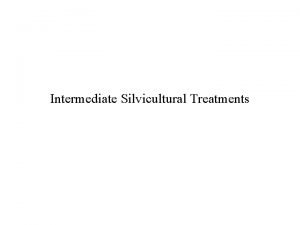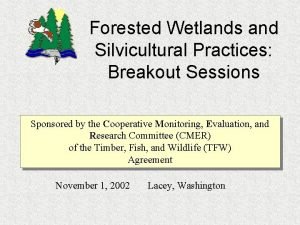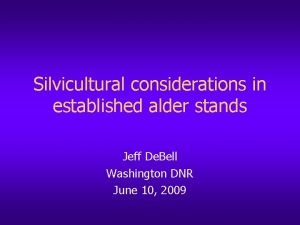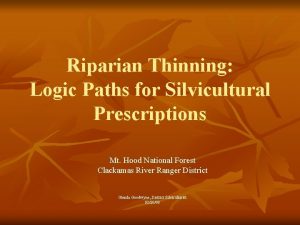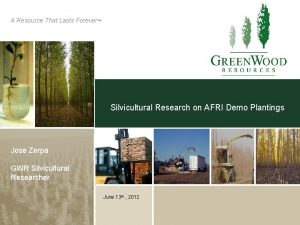The Marteloscope an innovative concept for silvicultural training









![I+ simulations Potential economic value (30 yrs) [Euros] Simulation 30 years 100 Ecological and I+ simulations Potential economic value (30 yrs) [Euros] Simulation 30 years 100 Ecological and](https://slidetodoc.com/presentation_image/ea3aa02c07d9b5c4c43f7d00bd737f42/image-10.jpg)


- Slides: 12

The Marteloscope – an innovative concept for silvicultural training Daniel Kraus EFICENT, Freiburg M-scopes Tree evaluation I+ software Results and training

Integrate + “Establishing a European network of demonstration sites for the integration of biodiversity conservation into forest management (Integrate+)” • 2013 -2016, financed by German BMEL • Establishment of European training site network • Development of mobile training software • Silvicultural training • Collaboration with partners from research and practice • Building up crossborder exchange of experiences

Silviculture – how to do it right? • Core principle of forest management: to decide where, when and which silvicultural intervention is necessary = ƒ(ecolog. preconditions, stand characteristics, societal demands and expectations) • Great importance of silvicultural experience => „waldbaulicher Götterblick“? ! • Even when silvicultural guidelines are available: still large scope for action => how different are the consequences? • Experimental silviculture („trial and error“) as a solution? Rather difficult: e. g. Time span, value of forests, no identical stand types, . . .

Martelowhat? • Instead: ‚simulated‘ silviculture? • Simulation of different interventions allows quantitative comparisons in the same stand • How can that be done? => Marteloscope! Term: le marteau (fr. ) = hammer; „marteler“ = select trees skopéin (gr. ) = to look at, watch Martelo-scope = ‚to have a closer look at a tree selection‘

What do we need? Real tree stand: • Exact area is known • All trees (above certain threshold) numbered and located • All trees are measured (at least species, x, y-coordinates, dbh, height; depending on silvicultural goals also other variables: habitat value, stability, fire resilience, . . . ) Establishment is work intensive, needs proper planning! Life span of Marteloscope is limited (until next intervention)

How is it done?

What can we do with it? Forest Silviculture Tree selection MARTELOSCOPES: practical silvicultural training tools Marteloscope Results Analysis Exchange

Single tree values • ecological evaluation of each single tree - Standardized assessment of tree microhabitats, including potential microhabitats - Criteria catalogue (23) - Assessment factors: rarity and development time • Economic evaluation - Volume functions (dbh, height, crown volume) - Quality assortment - Local timber prices - Estimation of future quality development

Habitat values Saproxylic Microhabitats Criteria list Tree microhabitats Cracks and scars Cavities CV 5 IN 1 Injuries and Wounds IN 2 Bark Deadwood Conks Epixylic Microhabitats Woodpecker cavities IN 3 BA 1 DW 1 GF 1 Growth orm related GF 2 microhabitats GF 3 EP 1 EP 2 EP 3 Epiphytic krypto- and phanerogams Trunk and mould cavities CV 1 CV 2 CV 3 CV 4 NE 1 OT 1 Other microhabitats OT 2 Nests and aeries Woodpecker cavities Trunk and mould cavities Branch holes Dendrotelms and water-filled holes Insect galleries and bore holes Bark loss / Exposed sapwood Exposed heartwood / Stem and crown breakage Cracks and scars Bark pockets Dead branches and limbs / crown deadwood Root buttress cavities Witch broom Cankers and burrs Fruiting bodies fungi Myxomycetes Bryophytes Foliose lichens Lianas Ferns Misteltoe Nests / aeries Sap and resin run Microsoil
![I simulations Potential economic value 30 yrs Euros Simulation 30 years 100 Ecological and I+ simulations Potential economic value (30 yrs) [Euros] Simulation 30 years 100 Ecological and](https://slidetodoc.com/presentation_image/ea3aa02c07d9b5c4c43f7d00bd737f42/image-10.jpg)
I+ simulations Potential economic value (30 yrs) [Euros] Simulation 30 years 100 Ecological and economic value [points; Euros] 50 50 Scenario 1: Scenario 2: Removal 53. 6 m 3 Removal 10 3. 2 m 3 0 0 0 50 0 100 Potential ecological value (30 yrs) [Points] 50 100 Potential ecological value (30 yrs) [Points] 100 Ecological value (after removal) [Points] 50 3451 2753 50 Potential ecological value (30 yrs) [Points] 4765 3767 0 0 0 50 100

Group results

Integrate+ Marteloscope network
 What is silviculture
What is silviculture Gary kerr omaha
Gary kerr omaha Silvicultural system
Silvicultural system Marteloscope definition
Marteloscope definition Innovative training techniques
Innovative training techniques Classroom
Classroom Formuö
Formuö Novell typiska drag
Novell typiska drag Nationell inriktning för artificiell intelligens
Nationell inriktning för artificiell intelligens Vad står k.r.å.k.a.n för
Vad står k.r.å.k.a.n för Shingelfrisyren
Shingelfrisyren En lathund för arbete med kontinuitetshantering
En lathund för arbete med kontinuitetshantering Underlag för särskild löneskatt på pensionskostnader
Underlag för särskild löneskatt på pensionskostnader
